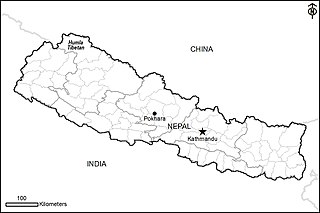Related Research Articles
Ethnologue: Languages of the World is an annual reference publication in print and online that provides statistics and other information on the living languages of the world. It is the world's most comprehensive catalogue of languages. It was first issued in 1951, and is now published by SIL International, an American evangelical Christian non-profit organization.
Avar, also known as Avaric, is a Northeast Caucasian language of the Avar–Andic subgroup that is spoken by Avars, primarily in Dagestan. In 2010, there were approximately 1 million speakers in Dagestan and elsewhere in Russia.

Magar Kham, also known as Kham, Kham Magar, and Khamkura, is the Sino-Tibetan language variety of the Northern Magar people of Nepal. The language is situated in the upper elevations of Baglung, East Rukum, and Rolpa districts. Based on census data taken in 2011, the total population of Magar Kham is estimated to be about 69,000 speakers.

Gurung, also known as Tamu Kyi or Tamu Bhāṣā, is a Sino-Tibetan language spoken by the Gurung people of Nepal. The total number of all Gurung speakers in Nepal was 227,918 in 1991 and 325,622 in 2011.

Tamang is a term used to collectively refer to a dialect cluster spoken mainly in Nepal, Sikkim, West Bengal (Darjeeling) and North-Eastern India. It comprises Eastern Tamang, Northwestern Tamang, Southwestern Tamang, Eastern Gorkha Tamang, and Western Tamang. Lexical similarity between Eastern Tamang and other Tamang languages varies between 81% and 63%. For comparison, lexical similarity between Spanish and Portuguese, is estimated at 89%.
Jawi or Djawi or Djaui, is a nearly extinct dialect of the Bardi language of Western Australia, the traditional language of the Jawi people. There are no longer any known fluent speakers, but there may be some partial speakers.
Chakato is a West Chadic language spoken in Plateau State, Nigeria. It was identified by Roger Blench in 2016. It is spoken by about 500 people in one village, Dokan Tofa, which is located on the Jos-Shendam road in Plateau State. Blench (2017) suggests that Chakato may be related to spurious records of the Jorto language. Chakato speakers claim that their language is closely related to Goemai.
Central Tibetan, also known as Dbus, Ü or Ü-Tsang, is the most widely spoken Tibetic language and the basis of Standard Tibetan.
Thangmi, also called Thāmī, Thangmi Kham, Thangmi Wakhe, and Thani, is a Sino-Tibetan language spoken in central-eastern Nepal and northeastern India by the Thami people. The Thami refer to their language as Thangmi Kham or Thangmi Wakhe while the rest of Nepal refers to it as Thāmī. The majority of these speakers, however, live in Nepal in their traditional homeland of Dolakhā District. In India, the Thami population is concentrated mostly in Darjeeling. The Thangmi language is written using the Devanagari script. Thangmi has been extensively documented by Mark Turin.
Rawat (Raute), or "Jangali" (Jungle), is a small Sino-Tibetan language of India. It is spoken in 9 villages north of Askot in Pithoragarh district, Uttarakhand, India (Ethnologue) as well as in several villages in Dadeldhura District, Nepal and Darchula District, Nepal.
Parsi has been used as a name for several languages of South Asia and Iran, some of them spurious:

Kyirong–Kagate is a subgroup of Tibetic languages spoken primarily in Nepal, with a hundred or so speakers across the border in Tibet.

Kagate or Syuba is a language from the subgroup of Tibetic languages spoken by the Kagate people primarily in the Ramechhap district of Nepal.
Anu-Hkongso is a Sino-Tibetan language spoken between the Kaladan and Michaung rivers in Paletwa Township, Chin State, Burma. It is closely related to Mru, forming the Mruic language branch, whose position within Sino-Tibetan is unclear. It consists of two dialects, Anu (Añú) and Hkongso.
Gyalsumdo is a mostly undocumented Tibetic language spoken by an estimated 200 individuals of the Manang District in the Gandaki Zone of Nepal. In January 2018 the language was added to ISO 639-3 under the code "gyo."

Nubri is a Tibeto-Burman language spoken by about 2000 ethnically Tibetan people living in Nubri Valley in northern Central Nepal, upper Gorkhā District of Gandaki Province. Nubri has at least three dialects as typified by the Prok, Lho and Sama village varieties. Nubri is largely undocumented and undescribed, with the exception of a lexicon. Nubri is perhaps most closely related to neighbouring Tsum language and the Kyirong variety of Tibetan spoken just across the border in Tibet. It has also been claimed to be closely related to Gyalsumdo. Like these languages it is tonal and shares many Tibetic grammatical features, but is uniquely different in many ways.
Karmarong language, also known as Karmai kat or Kar-ket, is the Sino-Tibetan language of the Karmarong people (Tibetan) of Mugu district in Nepal.

Mugom-Karmarong is the Sino-Tibetan language variety of the Tibetan people of Mugu district in Nepal. This language variety represents two dialects Mugom and Karmarong, which are spoken by distinct ethnicities and are separate language in the perceptions of these groups. Based on census data taken in 2011, the total population of Mugom-Karmarong is estimated to be about 7,500 speakers.

Humla Tibetan, also known as Humla Bhotiya, and Humli Tamang, is the Sino-Tibetan language of the Tibetan people of Humla district in Nepal.

Lhowa (ल्होवा), also known as Loke Tibetan, Mustang Tibetan and Lhopa is a Sino-Tibetan language spoken by approximately 3,000 Tibetan people of Mustang District in central Nepal.
References
- 1 2 "Mugom". Ethnologue. Retrieved 2022-07-01.
- ↑ "Glottolog 4.6 - Mugom". glottolog.org. Retrieved 2022-07-01.
- 1 2 3 Japola, Mari-Sisco. (2002). Mugom Survey. United Mission to Nepal, Mugu Education Project internal report: unpublished.
- ↑ Central Bureau of Statistics. (2014). National population and housing census 2011. Kathmandu: Government of Nepal.
- ↑ Lewis, M. Paul, and Gary F. Simons. (2016). Sustaining language use: Perspectives on community based language development. Dallas, TX: SIL International.
